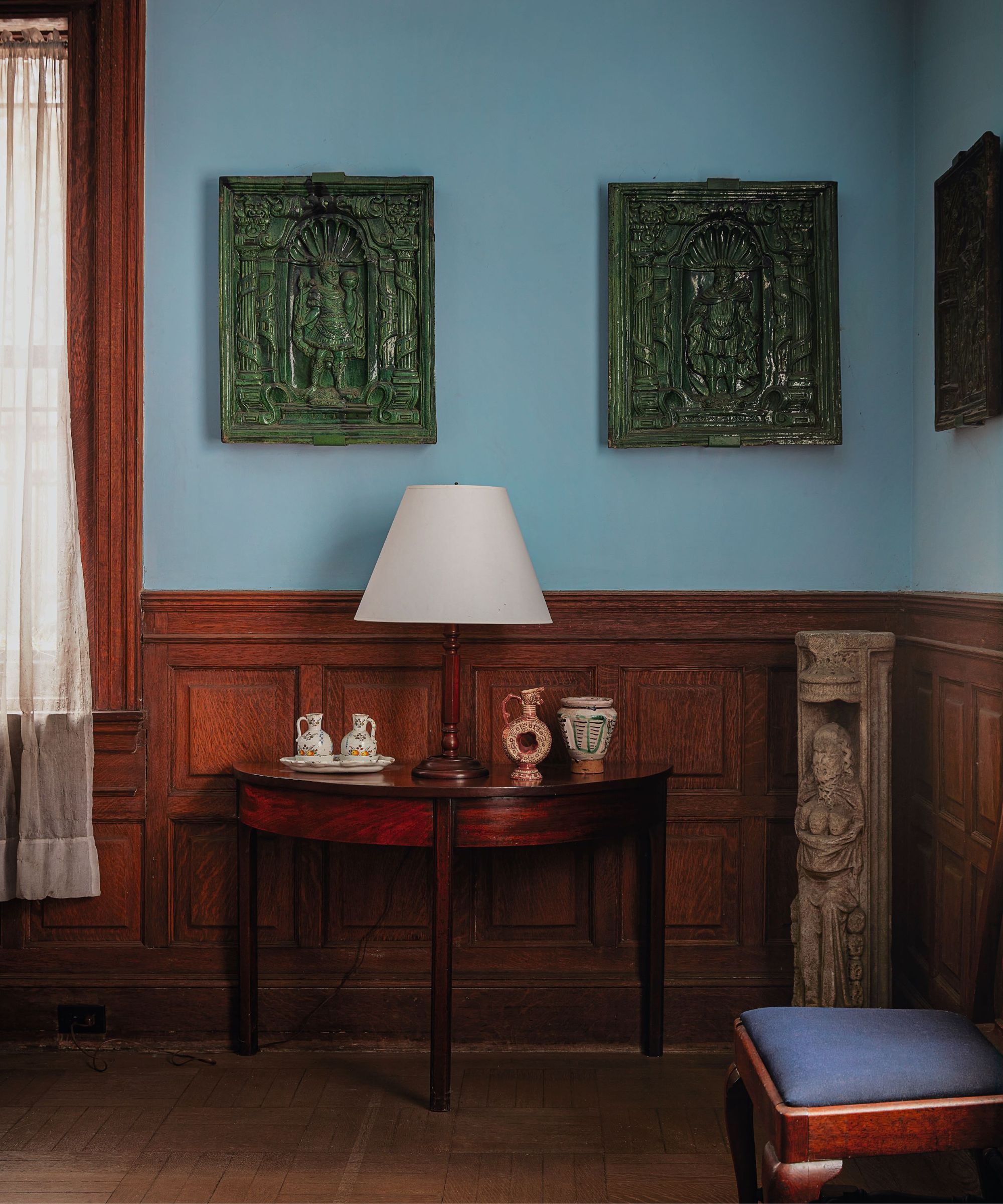This fascinating, colorful Harlem house is home to 10,000 books, and a literary couple
For literary couple James Fenton and Darryl Pinckney, a Harlem house proved the ideal backdrop to their books and treasured antiques


When British poet James Fenton and American writer Darryl Pinckney found their 1890 house in New York’s Harlem, their challenge was not only to breathe new life into its dilapidated interiors but to work out how to best accommodate their books.
'I’m told we’ve amassed more than 10,000, but I can’t say I’ve ever counted,’ says James.
The couple, who has taken decorating with books to a whole new level, moved out of their Washington Heights apartment nearby when it became clear that their ever-growing collection showed little sign of slowing pace.

Books are spread informally on floors and surfaces as well as in dedicated library spaces
‘When books feature in a scheme for decorative purposes they do add a certain warmth,’ says James. ‘However, our collection is also a working reference library, so we needed a different approach. They are organized alphabetically, by subject and language, across several rooms, so we had to accept that tall books would sit next to short, skinny with fat.’

Original woodwork is enlivened by stripes, a colorful 1920s woven fabric and brightly painted walls
And the story of the house is equally rich. Built by Boston artist Frank Hill Smith for John Dwight, co-inventor of Arm & Hammer baking soda, the property had a chequered history by the time James and Darryl chanced upon it 12 years ago.

Restored plasterwork takes center stage in this newly restored space, picked out by walls in a bold yellow tone
Despite this, their books add a sense of grace to these rooms. Housed partly in Vitsœ’s iconic shelving system, the couple’s books represent a lifetime of academia.

A 14ft dining table, whose 18th-century top was sourced from an old farmhouse in Hudson, takes center stage in this room, whose subway tiles have been preserved
‘At that point, it was on the verge of being bought by a developer after stints as a school, synagogue, community art center and, latterly, bedsits,’ says James. ‘Although neither of us were in the market for an historical renovation, that’s what we took on.’
Design expertise in your inbox – from inspiring decorating ideas and beautiful celebrity homes to practical gardening advice and shopping round-ups.

The mahogany walls and stucco ceiling are original to the house, which was built in 1890 in the Neo-Renaissance style
Behind its bow-windowed façade sit four oval rooms, one on top of the other, attached to a rectangular building with a 1920s addition. Stained-glass windows, ornate wood carved doors and stucco ceilings had long been obscured by partition walls or wallcoverings.

Once the billiard room, this space features an original wainscot and parquet flooring
But with the help of architect Samuel G White, former assistant professor of Fine Arts at New York University, the house was slowly returned to its near-original state.
‘We wanted an architect who could see the point of saving all this fine detailing,’ says James. ‘Another breakthrough came when we were sent pictures of the house by the descendants of its first owner. Dated 1925, the photographs showed how the interiors once looked.’

The oval shape of this second-floor space, once obscured by partition walls, is picked out in a blue trim. The Breccia marble fireplace makes an impressive centerpiece
Now, the rooms have been returned to their original configuration, with a nod to modern living (the former billiard room is now a dining room leading to a kitchen).
'We added our own layer to this home by commissioning a series of friezes inspired by Moroccan mosaics and Renaissance carvings.'

James and Darryl share a love of bold colors, seen here in a combination of primary hues
Stone-effect painted hallway walls and faux bois friezes have been added by artist Jane Warrick and rooms have been treated to rich jewel tones, from emerald green and sunshine yellow to deep red and bright blue. All of these throw the original features into a fresh, new context.

A large English desk anchors the second-floor library, which is dedicated to books on the decorative arts
The pair say further concessions to modern living may be required – not least the addition of air-con – but for now they are content to enjoy its rarefied atmosphere.
‘It’s an ideal home for two writers,’ says James. ‘We can easily get our hands on any book we need and there’s room to read, write and reflect.’

Shades of green bring an earthy feel to this space, which features tongue-and-groove panelling. ‘This home is decorated in an interpretation of American style,’ explains James
■ I Can See A Room: Classic Essays in Interior Design edited by James Fenton is out in 2023 (FSG); Come Back In September by Darryl Pinckney (FSG/Picador UK) is currently on sale

Emma writes across interiors, design, lifestyle, and travel for a number of titles, from The Times Magazine to Living Etc. A born and bred Londoner, she has written two books that celebrate her passion for architecture and design in the capital, including London Shopfronts and London Interiors.